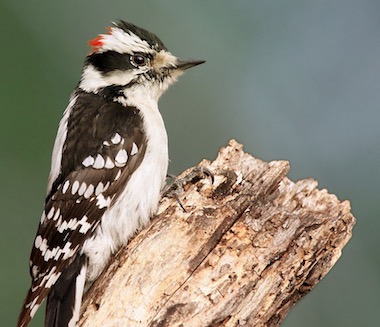866-295-4143, fbns@wayoflife.org

Downy Woodpecker
Some woodpeckers work together to stash acorns into trees. One such “granary” tree created by some very busy birds contained 50,000 acorns.
More than 180 species of these amazing pecking machines are found throughout the world (except Australia, New Zealand, and Madagascar).
Some types of woodpeckers, called sapsuckers, extract sap and eat insects attracted by sap.
The largest extant woodpecker is the great slaty of South and Southeast Asia, which can reach 23 inches in length. It is various shades of gray set off by bright orange coloring on its cheek and neck.
The smallest woodpecker in North America is the downy, which is five to seven inches long. The downy is the most common backyard woodpecker in North America. It has a white body, black wings with white splotches, and a black and white head set off with a bright red spot on the back of the head.
The smallest woodpecker in the world is the piculet, which is a minuscule 2 to 4 inches in length. It lives mainly in tropical South America, though there are some in Southeast Asia. They have a very small tail.
Many woodpeckers are beautifully colored. Several have bright red heads. These include the gorgeous red-headed woodpecker (Melanerpes erythrocephalus). With its brilliant red head, snowy white body and inky black wings, it has been called a “flying checkerboard.” It is adept at catching insects on the wing.
Another red-headed beauty is the pileated woodpecker (Dryocopus pileatus). Its bright red head feathers form a noble pointed crown. It has a black body with white stripes on its throat, cheek, and neck. The pileated is the largest woodpecker in North America, 16-19 inches in length. Its pecking is a very loud drumming that can sound like a hammer.
The most famous woodpecker is the animated Woody Woodpecker, created by Ben Hardaway in 1940. Hardaway also created Bugs Bunny and Daffy Duck.
Woodpeckers do not sing, though they can make “chirps, chatters, and other alarm calls.” They seem to use drumming as a communication tool.
The woodpecker has “zygodactil” feet, with two toes facing forward and two facing backward that allow it to grip tight to a tree. (The exception is the three-toed woodpecker.) This is unlike the songbird which has “anisodactyl” feet, with three toes pointing forward and one pointing backward. The woodpecker’s feet are especially tough and strong.
The tail of most woodpeckers has specialized sharp spikes that dig into the tree’s bark. In combination with its feet, the tail spikes form a tripod for stability.
This “tripod,” together with its perfectly distributed body and feather weight, means it can stand comfortably in an upright position while hammering away at the tree.
The woodpecker has a specialized tongue that is up to four inches long and wraps around the skull when retracted. Many have barbed tongues to better extract bugs from holes.
The woodpecker is monogamous, mating for life.
Most woodpeckers fly in an undulating manner, flapping a few times with its wings, then gliding.
Though the woodpecker has many other wonderful features, we want to focus on its pecking.
It is able to peck 20 times per second and can do this 12,000 times in a day. These are not gentle pecks. The creature’s beak strikes the tree at a speed of 15 miles per hour and produces an incredible G-force of 1,200. This “is the equivalent of going from 26,000 miles per hour to a complete stop every second” (“Bird Brains,” Forbes, Jan. 6, 2016). A human, on the other hand, can sustain a maximum G-force of 100, and brain injury and death often occur at much lower forces. So the little bird can sustain G-forces on its brain of more than 100 times that of a human.
In recent decades, the woodpecker has been the object of much scientific study, and it turns out that it has the following design features ideally suited to its business:
First, its brain is much smaller than a human brain. Dr. Lorna Gibson, a materials science professor at MIT who has studied woodpeckers, says, “A human brain has a mass of 1,400 grams. A woodpecker’s brain is only 2 grams. That’s the mass of two paperclips. It is a scaling phenomenon. While this might seem like a highfalutin concept, this is something that we instinctually understand. If you dropped your cellphone from your nightstand, it would survive. But if you dropped your laptop from the same height, you might have to take a trip to the Apple store. The same goes for brains: The smaller the brain, the better its chance of surviving an impact” (“Why Don’t Woodpeckers Get Concussions?” Huffington Post, Nov. 25, 2013).
Second, its skull is made of plate-like bones with a “spongy” structure at strategic locations to protect the brain. “At a microscopic level, woodpeckers have a large number of trabeculae, tiny beamlike projections of bone that form the mineral ‘mesh’ that makes up this spongy bone plate. These trabeculae are also closer together than they are in the skylark skull, suggesting this microstructure acts as armor protecting the brain” (“Why Don’t Woodpeckers?” LiveScience, Apr. 10, 2012).
Third, the woodpecker’s brain fits tightly into the skull (unlike the human brain) so that it doesn’t “slosh” around and cause damage.
Fourth, the woodpecker’s brain is oriented differently than the human brain so that the force is distributed over a greater area. It is “longer top-to-bottom than front-to-back, meaning the force against the skull is spread over a larger brain area.”
Fifth, the woodpecker has a hyoid bone that wraps around the entire brain cage to form a “safety belt.”
Sixth, the woodpecker’s beak is cleverly built to absorb energy while still allowing the little creature to punch holes in wood. “The upper and lower halves of the birds’ beaks were uneven, and as force was transmitted from the tip of the beak into the bone, this asymmetry lowered the load that made it as far as the brain” (“How Woodpeckers Avoid Head Injury,” BBC News, Oct. 27, 2011).
Seventh, the woodpecker changes the direction of its pecking attack by moving its head and beak around in just the right way as it hammers. By this means, woodpeckers “minimize the number of times in a row that the brain and skull make contact at the same point” (“Why Woodpeckers Don’t Get Brain Damage?” Mental Floss, Nov. 24, 2014). Smart!
Eighth, the woodpecker uses its entire body to absorb the energy of the pecking. They “hit their targets in a straight, consistent line” and “with each hit, the entire body of the bird knows what motion will take place, which muscles will be used and any rotation that would cause strain is avoided” (Forbes).
Researchers have found that through these mechanisms, “99.7 percent of the impact energy from striking a tree is absorbed by the body” (Mental Floss).
Other design features include a nictitating membrane that closes over the eye a fraction of a second before its beak strikes wood, thus protecting the eye from debris, cleaning it, and conveniently keeping it from popping out of the creature’s head!
The woodpecker also has bristles on its nostrils and special air sacs to prevent inhalation of wood particles.
EVOLUTION?
In spite of the discovery of all of these complex biological engineering marvels, evolutionists persist in the delusion that such things were formed by blind evolution. One report says, “In an average day, a woodpecker does this around 12,000 times, and yet they don’t seem to hurt themselves or be the least bit bothered by it. This is because, after millions of years of this type of behavior, they’ve evolved some specialized headgear to prevent injuries to their heads, brains, and eyes.”
This is a ridiculous statement from every perspective. How could a creature survive to “evolve” something that is necessary for its very existence? And how could such things evolve? Evolutionists have proposed zero scientifically-supported evolutionary mechanisms that could build up the vast and mind-bogglingly complex DNA sequences necessary to create complex organs. “Natural selection” is not creative. It can only select from existing genetic code. “Mutations” aren’t creative; they are overwhelmingly destructive. Believe me, you don’t want to pass on mutations to your offspring.
I’m glad that I can be my own scientist and weigh the facts for myself. I accept the fascinating true science that has enabled the discovery of these things about the woodpecker (e.g., scanning electron microscopes, CT scanners, force/torque sensors, high-speed cameras, computer simulations, 3D modeling), but I reject the “philosophy pretending to be science” that is haphazardly tossed into these reports.
For those who have eyes to see, the woodpecker is irrefutable evidence of an Almighty, all-wise Creator. To know Him personally, I recommend my favorite book, the Bible, which is the gracious revelation of God’s character and plan of salvation to mankind through Jesus Christ.
“For God so loved the world, that he gave his only begotten Son, that whosoever believeth in him should not perish, but have everlasting life. For God sent not his Son into the world to condemn the world; but that the world through him might be saved. He that believeth on him is not condemned: but he that believeth not is condemned already, because he hath not believed in the name of the only begotten Son of God” (John 3:16-18).
- Receive these reports by email
- www.wayoflife.org
______________________
Sharing Policy: Much of our material is available for free, such as the hundreds of articles at the Way of Life web site. Other items we sell to help fund our expensive literature and foreign church planting ministries. Way of Life's content falls into two categories: sharable and non-sharable. Things that we encourage you to share include the audio sermons, O Timothy magazine, FBIS articles, and the free eVideos and free eBooks. You are welcome to make copies of these at your own expense and share them with friends and family. You may also post parts of reports and/or entire reports to websites, blogs, etc as long as you give proper credit (citation). A link to the original report is very much appreciated as the reports are frequently updated and/or expanded. Things we do not want copied and distributed are "Store" items like the Fundamental Baptist Digital Library, print editions of our books, electronic editions of the books that we sell, the videos that we sell, etc. The items have taken years to produce at enormous expense in time and money, and we use the income from sales to help fund the ministry. We trust that your Christian honesty will preserve the integrity of this policy. "For the scripture saith, Thou shalt not muzzle the ox that treadeth out the corn. And, The labourer is worthy of his reward" (1 Timothy 5:18). Questions? support@wayoflife.org
Goal:Distributed by Way of Life Literature Inc., the Fundamental Baptist Information Service is an e-mail posting for Bible-believing Christians. Established in 1974, Way of Life Literature is a fundamental Baptist preaching and publishing ministry based in Bethel Baptist Church, London, Ontario, of which Wilbert Unger is the founding Pastor. Brother Cloud lives in South Asia where he has been a church planting missionary since 1979. Our primary goal with the FBIS is to provide material to assist preachers in the edification and protection of the churches.
Offering: Offerings are welcome if you care to make one. If you have been helped and/or blessed by our material offerings can be mailed or made online with with Visa, Mastercard, Discover, or Paypal. For information see: www.wayoflife.org/about/makeanoffering.html.





